
THE STORY OF "BEEP" THE LEGENDARY GREATER ROADRUNNER OF COYOTE LAKES GOLF COURSE IN SURPRISE, AZ
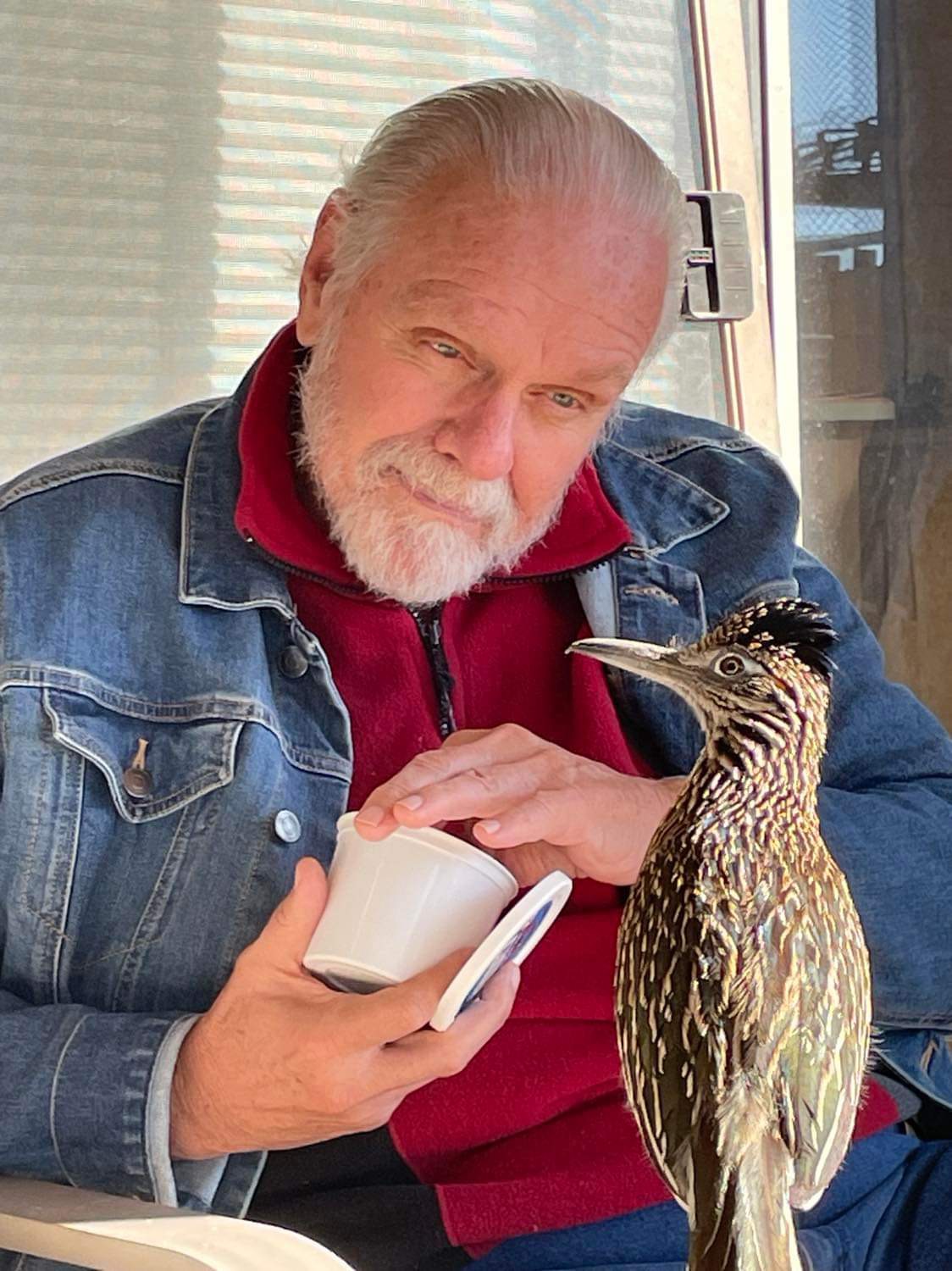
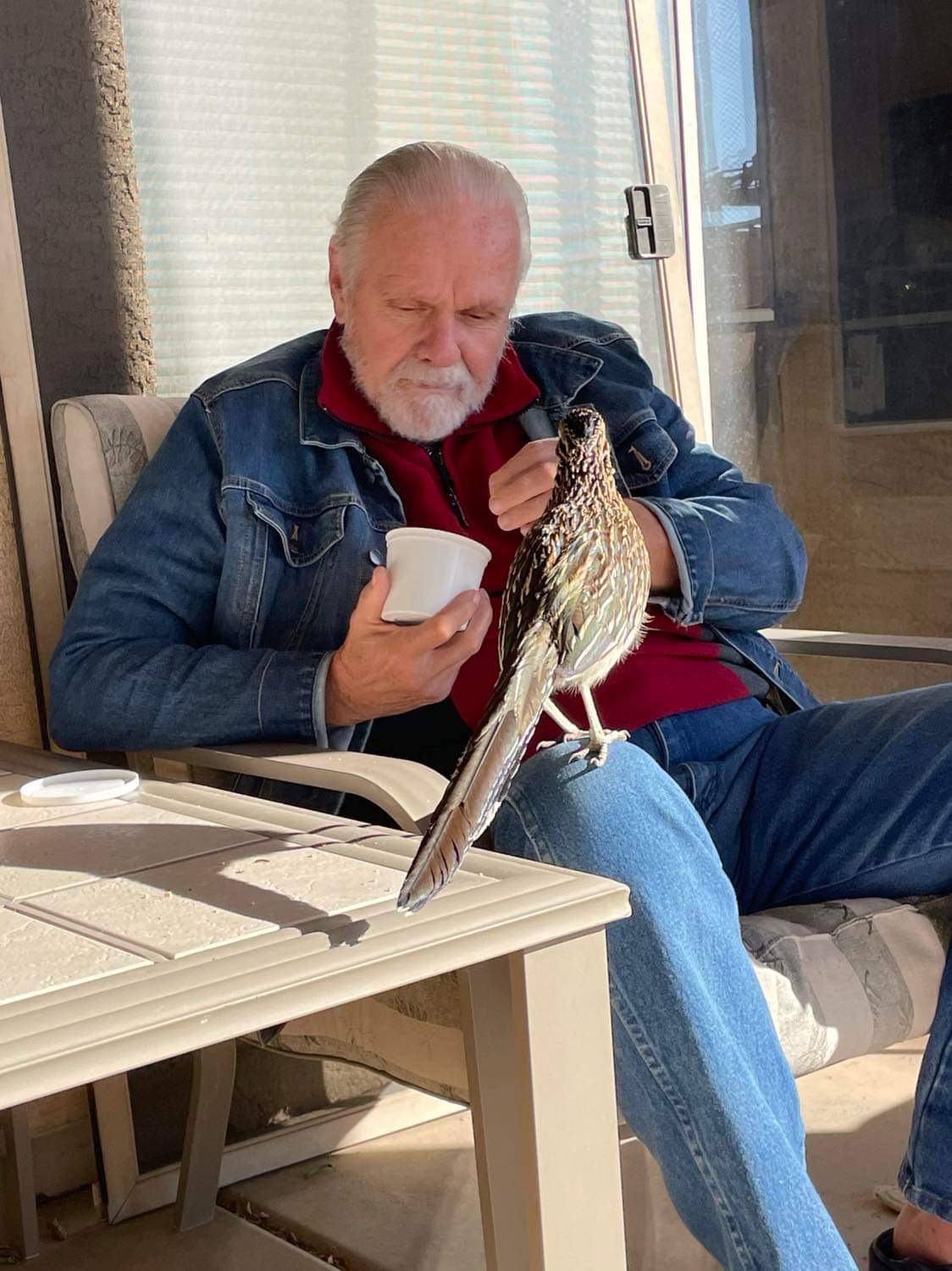
We live on the 8th hole at the Coyote Lakes Golf Course in Surprise, Arizona. Beep Beep (Beep) showed up one day in November 2023 and never left. Beep shows up to our home most everyday about 4:00-5:00 PM and roosts on our backyard nightlight. We realized this one day when Beep showed up about 4:00 PM and came up to my dog (Joli) and I like he owned the place. He then jumps on our nightlight and spent the night. I was amazed that he was unafraid of Joli and I.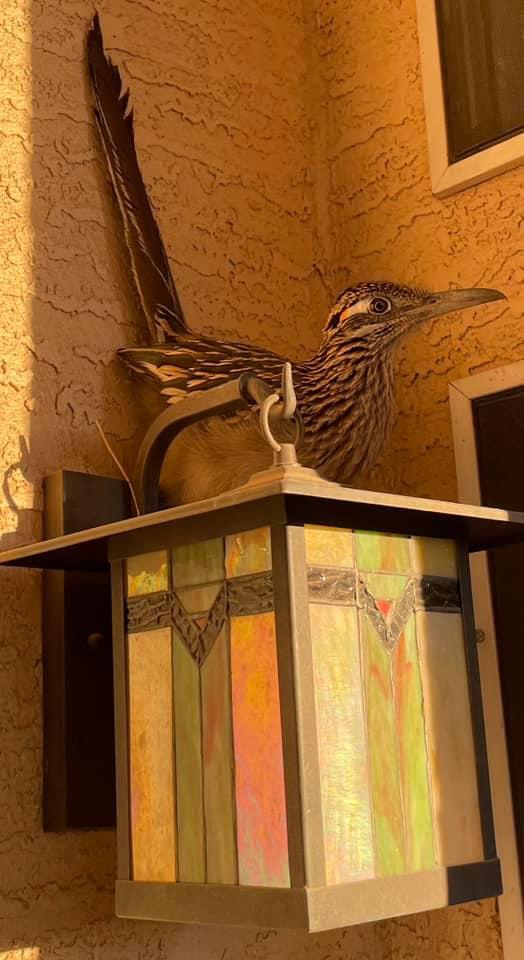 I went to PetSmart and purchased live night crawlers and mealworms. When he returned at 4:00 the next day I fed him the worms. He took them straight from my fingers. He then jumped to his perch (Our Nightlight) to roost for the rest of the night. I went to PetSmart and purchased live night crawlers and mealworms. When he returned at 4:00 the next day I fed him the worms. He took them straight from my fingers. He then jumped to his perch (Our Nightlight) to roost for the rest of the night.As you can see Beep now pecks on our door trying to get into our home for more worms. We have created a little monster, but we love him. _____________________________________________ UPDATE MARCH 2024 Beep continues to roost on our nightlight most every night. I now feed him earthworms, mealworms or hamburger most everyday. Beep leaves his roost every morning at sunrise and usually returns every late afternoon. I really don't know for sure if Beep is a male or female. Beep has never laid an egg so I am assuming Beep is a male. To this point I have not seen a mate but neighbors have said they have seen two roadrunners on the 8th hole at Coyote Lakes. _____________________________________________ UPDATE MAY 2024Beep doesn't show up as often now. I believe he/she is mating and Beep helps by sitting on the eggs. Beep shows up about every other day now and has stopped roosting on our backyard night lite. We are getting ready to leave Arizona for Indiana. I have asked the locals to protect Beep. Beep is on the 8th hole of the Coyote Lakes Golf Course. This beautiful bird has made the past six months exceptional for me. I will definitely miss him this summer and hope Beep misses me also. Hopefully he will still be here when we return. ________________________________________ UPDATE JUNE 2024 Beep had been roosting nightly on on our nightlight again. I believe his mating or sitting on eggs is over for now. We have returned to Indiana, arriving today 6-4-2024. I checked my security camera tonight and there was Beep looking for me. I have uploaded this video of him looking for me. The past 6 months, he usually came every night and I would feed him and then he jumps to his roost. A friend said he will check nightly and feed Beep occasionally. I will be very upset if something happens to Beep and I hope he will still be there when we return in October 2024. _________________________________________________ UPDATE JUNE 2025 Jorge my friend, checked on and occasionally fed Beep the summer of 2024. I followed Beep on our security camera. Each night I would watch Beep jump to his roost on our nightlight and getting up early each morning. I would check on Beep just about every day to make sure he was safe. In October 2024 we returned to Arizona. When we pulled up in our drive there was Beep greeting us. Of course we were excited seeing Beep again. Beep continued visiting us everyday and would jump to my knee and I would feed him mealworms. He would then jump to his roost for the night. I continued feeding Beep and checking on him daily. Beep would come visit when I called out Beep Beep and then I would feed and talk to him. I also started seeing other Roadrunners in my yard but Beep didn't seem to like any of them. The roadrunners would chase each other and then Beep would always returned. I took many videos and photos of Beep. Overtime Beep and I become very close. I started loving Beep more and more each time he visited. My feelings for him become just as strong for him as any household pet. I actually was surprised that I would love Beep like anyone of my past pets. Beep was a special and unusual Bird. This went on through out the winter of 2025. When May came we again got ready to leave for Indiana. The day before we left Beep showed up and I fed him and told him goodbye as he sat on my knee. The next morning I watched him eat his breakfast. Before we left we setup Jorge to feed Beep occasionally and check on him often. It really hurt me to leave Beep in Arizona by himself. We left Arizona for Indiana on May 22nd. I continued to watch Beep on my security camera. He would visit and appeared to be looking for me at times. I would check on him each and everyday. 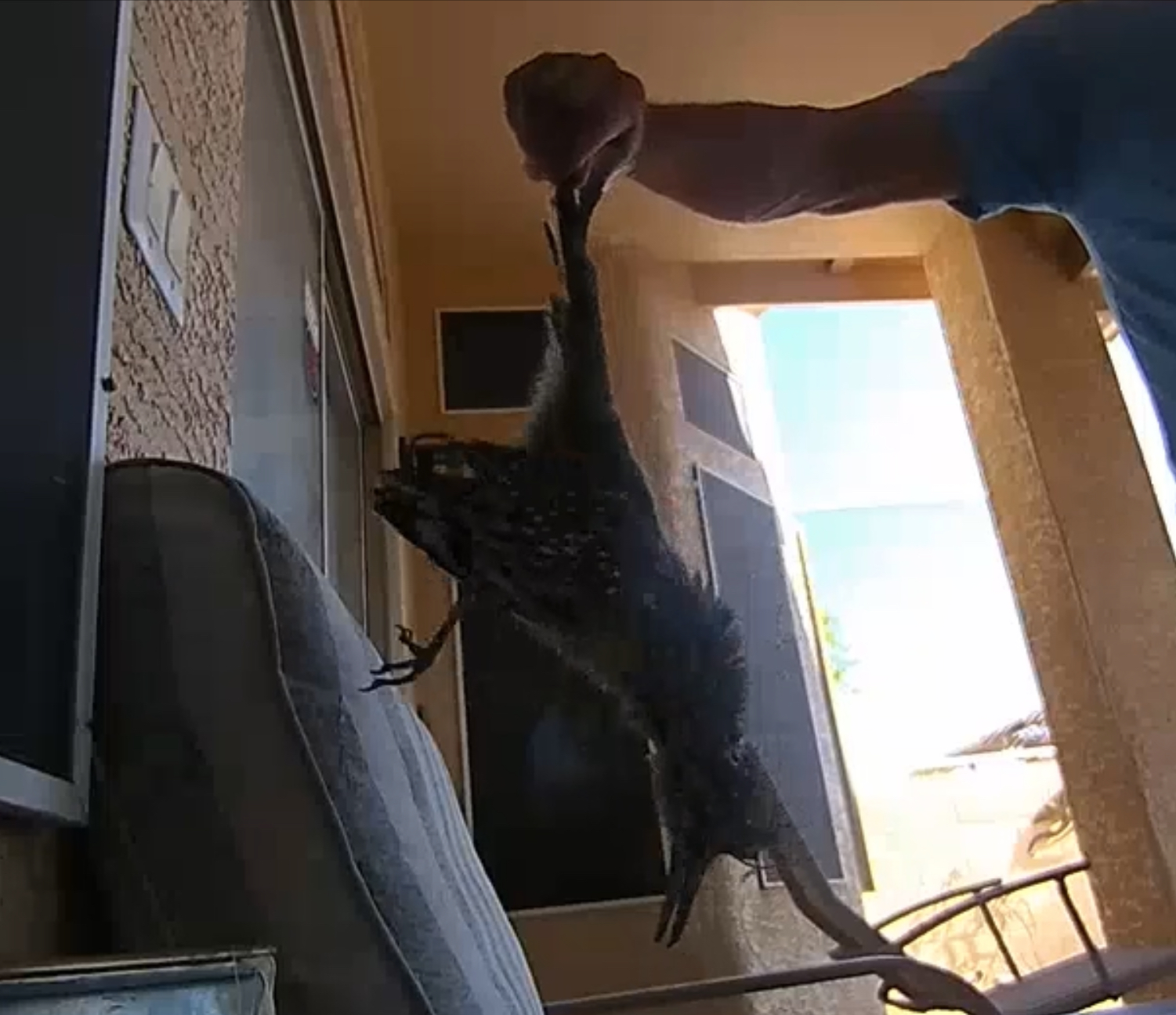 The following is very sad for me. Tears are coming to my eyes as I write this. On June 10th our next door neighbor called and left a message that there was a dead Roadrunner in my back yard. My heart stopped as I called my neighbor back fearing the worst. She said her husband spotted a dead Roadrunner in my yard. I thanked her for calling and I immediately called Jorge. Jorge went to my home and found a dead roadrunner. We could not determine how the roadrunner died. Jorge buried the roadrunner in our back yard. I kept checking my security camera daily to see if the dead roadrunner was Beep or not. I hate to report this to the many neighbors who have been following my adventures with Beep. It is with a heavy heart and tears as I believe Beep has died. Jorge believes the dead roadrunner is Beep also. I don't believe he died from natural causes. He was a young bird. His feathers were not ruffled so I don't believe it was a coyote or hawk etc. I am thinking a rattlesnake as I have had them inside my yard occasionally. The following is very sad for me. Tears are coming to my eyes as I write this. On June 10th our next door neighbor called and left a message that there was a dead Roadrunner in my back yard. My heart stopped as I called my neighbor back fearing the worst. She said her husband spotted a dead Roadrunner in my yard. I thanked her for calling and I immediately called Jorge. Jorge went to my home and found a dead roadrunner. We could not determine how the roadrunner died. Jorge buried the roadrunner in our back yard. I kept checking my security camera daily to see if the dead roadrunner was Beep or not. I hate to report this to the many neighbors who have been following my adventures with Beep. It is with a heavy heart and tears as I believe Beep has died. Jorge believes the dead roadrunner is Beep also. I don't believe he died from natural causes. He was a young bird. His feathers were not ruffled so I don't believe it was a coyote or hawk etc. I am thinking a rattlesnake as I have had them inside my yard occasionally.
Beep visited me daily for going on three years. As an 82 year old man, I didn't think it would hurt this much of his passing. Many will say it's just a wild bird. He was more than this to me. He was my friend who visited me everyday and roost on our nightlight. I looked forward to seeing his visits everyday. I will miss him. He was my great friend. RIP Beep! NOW THE MYSTERY - Is Beep still alive! View the two videos below. These are videos of Roadrunners in my yard after the dead roadrunner was found. Are those videos of Beep? I really don't know for sure one way or another but I haven't seen Beep for nearly a month now. (July 5, 2025)__________________________________________ TO BE CONTINUED June 12, 2025 June 13, 2025 JUNE 29, MY BIRTHDAY_________________________________________________________ I have not seen Beep for over three weeks. I am thinking the worse. The dead roadrunner was probably Beep. Jorge says the live roadrunner I seen was probably not Beep but another, as he called Beep Beep and the roadrunner ran away. Beep always came when I called his name. I guess we will have to wait and see, but Jorge now believes the dead roadrunner was probably my beloved Beep. He was very special to me the past two years. Each and every night he would visit us and then jump to his roost. Our patio night light. On some days Beep would visit and sit with Pam and I and Joli on our patio chairs. Thanks for following Beep the Coyote Lakes Roadrunner. I actually loved my little buddy and will miss him. I believe he died in my yard, looking for me, but I wasn't there. A message from my Granddaughter: I hated reading about Beep Beep. I think he's alive and maybe just didn't recognize your friend right away and got frightened. I really hope he's okay and well. He's a cute little guy and I think it's so cool you made friends with a ROADRUNNER. My grandpa can do anything! IT HAS BEEN A MONTH NOW SINCE I HAVE SEEN BEEP ON MY SECURITY CAMERA. I AM NOW SURE THE ROADRUNNER FOUND DEAD IN MY BACKYARD WAS BEEP. I WILL MISS THE DAILY VISITS WITH BEEP SITTING ON MY KNEE AND LOOKING STRAIGHT INTO MY EYES WITH LOVE. I KNOW HE WAS A WILD BIRD BUT IT REALLY HURTS AND I WILL ALWAYS MISS HIM. I LOVED THAT LITTLE BIRD. I REALLY WISH I KNEW HOW BEEP DIED.. BEEP THE COYOTE LAKES ROADRUNNER IS ALIVE AND WELL My last post I reported that Beep was the dead roadrunner in my yard because we have not seen him in our security cameras for a month. Beep has shown up alive and well. My security camera spotted him on July 15th. I called Jorge to check and he went to the house. Yes, it was Beep and Jorge fed him. I have no idea who the dead roadrunner is. Below is a photo and a video of Jorge feeding Beep. Life is good! BEEP IS A COYOTE LAKES GOLF COURSE ROADRUNNER IN SURPRISE, ARIZONA 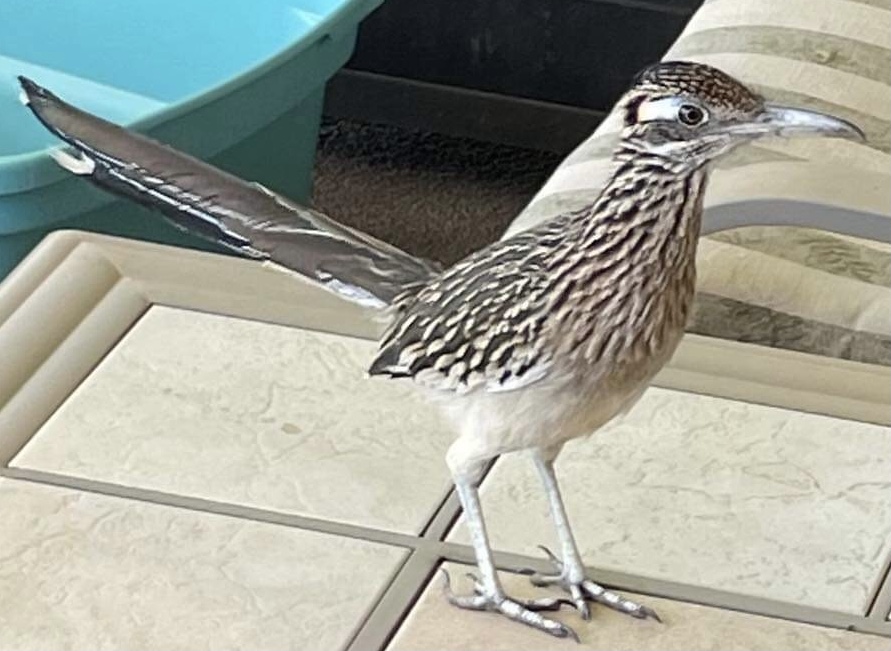 BEEP GETTING OUR ATTENTION THAT HE'S HUNGRY BEEP THE COYOTE LAKES ROADRUNNER Check out the video below of Beep looking for me.
THE ROADRUNNER (genus Geococcyx)also known as chaparral birds or chaparral cocks, are two species of fast-running ground cuckoos with long tails and crests. They are found in the southwestern and south-central United States, Mexico and Central America, usually in the desert. Although capable of flight, roadrunners generally run away from predators. On the ground, some have been clocked at 20 to 25 mph.The roadrunner generally ranges in size from 22 to 24 in. from tail to beak. The average weight is about 8 to 15 oz. The roadrunner is a large, slender, black-brown and white-streaked ground bird with a distinctive head crest. It has long legs, strong feet, and an oversized dark bill. The tail is broad with white tips on the three outer tail feathers. The bird has a bare patch of skin behind each eye; this patch is shaded blue anterior to red posterior. The lesser roadrunner is slightly smaller, not as streaky, and has a smaller bill. Both the lesser roadrunner and the greater roadrunner leave behind very distinct "X" track marks appearing as if they are travelling in both directions. The roadrunner has a slow and descending dove-like "coo". It also makes a rapid, vocalized clattering sound with its beak. Roadrunners inhabit the Southwestern United States, to parts of Missouri, Arkansas, and Louisiana, as well as Mexico and Central America. They live in arid lowland or mountainous shrubland or woodland. They are non-migratory, staying in their breeding area year-round. The greater roadrunner is not currently considered threatened in the US, but is habitat-limited. Below is a video and two audios of the Greater Roadrunner sounds. Tap the images below for sound.
The roadrunner is an opportunistic omnivore. Its diet normally consists of insects (such as grasshoppers, crickets, caterpillars, and beetles), small reptiles (such as lizards and snakes, including rattlesnakes), rodents and other small mammals, spiders (including tarantulas), scorpions, centipedes, snails, small birds (and nestlings), eggs, and fruits and seeds like those from prickly pear cactuses and sumacs. The lesser roadrunner eats mainly insects. The roadrunner forages on the ground and, when hunting, usually runs after prey from under cover. It may leap to catch insects, and commonly batters certain prey against the ground. The roadrunner is one of the animals that preys upon rattlesnakes; it is also the only real predator of tarantula hawk wasps. 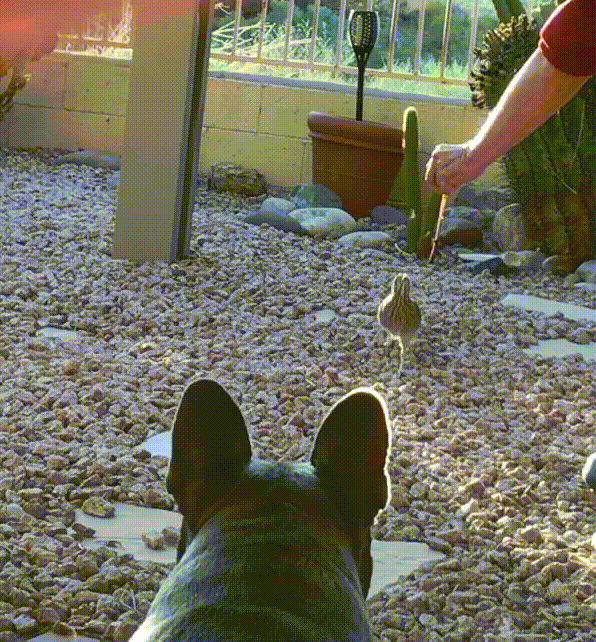 The roadrunner usually lives alone or in pairs. Breeding pairs are monogamous and mate for life, and pairs may hold a territory all year. During the courtship display, the male bows, alternately lifting and dropping his wings and spreading his tail. He parades in front of the female with his head high and his tail and wings drooped, and may bring an offering of food. The reproductive season is spring to mid-summer (depending on geographic location and species).
The roadrunner usually lives alone or in pairs. Breeding pairs are monogamous and mate for life, and pairs may hold a territory all year. During the courtship display, the male bows, alternately lifting and dropping his wings and spreading his tail. He parades in front of the female with his head high and his tail and wings drooped, and may bring an offering of food. The reproductive season is spring to mid-summer (depending on geographic location and species).The roadrunner's nest is often composed of sticks, and may sometimes contain leaves, feathers, snakeskins, or dung. It is commonly placed 1 to 3 meters (3 to 10 feet) above ground level in a low tree, bush, or cactus. Roadrunner eggs are generally white. The greater roadrunner generally lays 2 to 3 eggs per clutch, but the lesser roadrunner's clutches are typically smaller. Hatching is asynchronous. Both sexes incubate the nest (with males incubating the nest at night) and feed the hatchlings. For the first one to two weeks after the young hatch, one parent remains at the nest. The young leave the nest at two to three weeks old, foraging with parents for a few days after. Greater roadrunner warming itself in the sun, exposing the dark skin and feathers on its back During the cold desert night, the roadrunner lowers its body temperature slightly, going into a slight torpor to conserve energy. To warm itself during the day, the roadrunner exposes dark patches of skin on its back to the sun. 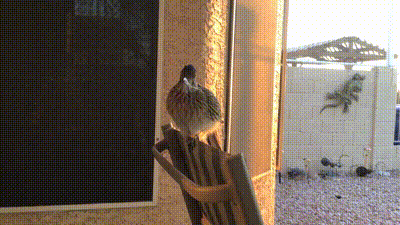 The Hopi and other Pueblo tribes believed that roadrunners were medicine birds and could protect against evil spirits. Their unusual X-shaped footprints are used as sacred symbols to ward off evil in many Pueblo tribes, partially because they invoke the protective power of the roadrunners themselves, and partially because the X shape of the tracks conceals which direction the bird is headed (thus throwing malignant spirits off track.) Stylized roadrunner tracks have been found in the rock art of ancestral Southwestern tribes like the Anasazi and Mogollon cultures, as well. Roadrunner feathers were traditionally used to decorate Pueblo cradleboards as spiritual protection for the baby. In Mexican Indian and American Indian tribes, such as the Pima, it is considered good luck to see a roadrunner. In some Mexican tribes, the bird was considered sacred and never killed, but most Mexican Indians used the meat of the roadrunner as a folk remedy to cure illness or to boost stamina and strength. The Hopi and other Pueblo tribes believed that roadrunners were medicine birds and could protect against evil spirits. Their unusual X-shaped footprints are used as sacred symbols to ward off evil in many Pueblo tribes, partially because they invoke the protective power of the roadrunners themselves, and partially because the X shape of the tracks conceals which direction the bird is headed (thus throwing malignant spirits off track.) Stylized roadrunner tracks have been found in the rock art of ancestral Southwestern tribes like the Anasazi and Mogollon cultures, as well. Roadrunner feathers were traditionally used to decorate Pueblo cradleboards as spiritual protection for the baby. In Mexican Indian and American Indian tribes, such as the Pima, it is considered good luck to see a roadrunner. In some Mexican tribes, the bird was considered sacred and never killed, but most Mexican Indians used the meat of the roadrunner as a folk remedy to cure illness or to boost stamina and strength.Indigenous peoples of Central America have developed numerous beliefs about the roadrunner and have taboos against harming the bird. The Ch'ol Maya believe roadrunners to have special powers. It is known to them as ajkumtz'u', derived from the bird's call that is said to make the listener feel tired. The word for roadrunner in the O'odham language is tadai, which is the name of a transit center in Tucson, Arizona. 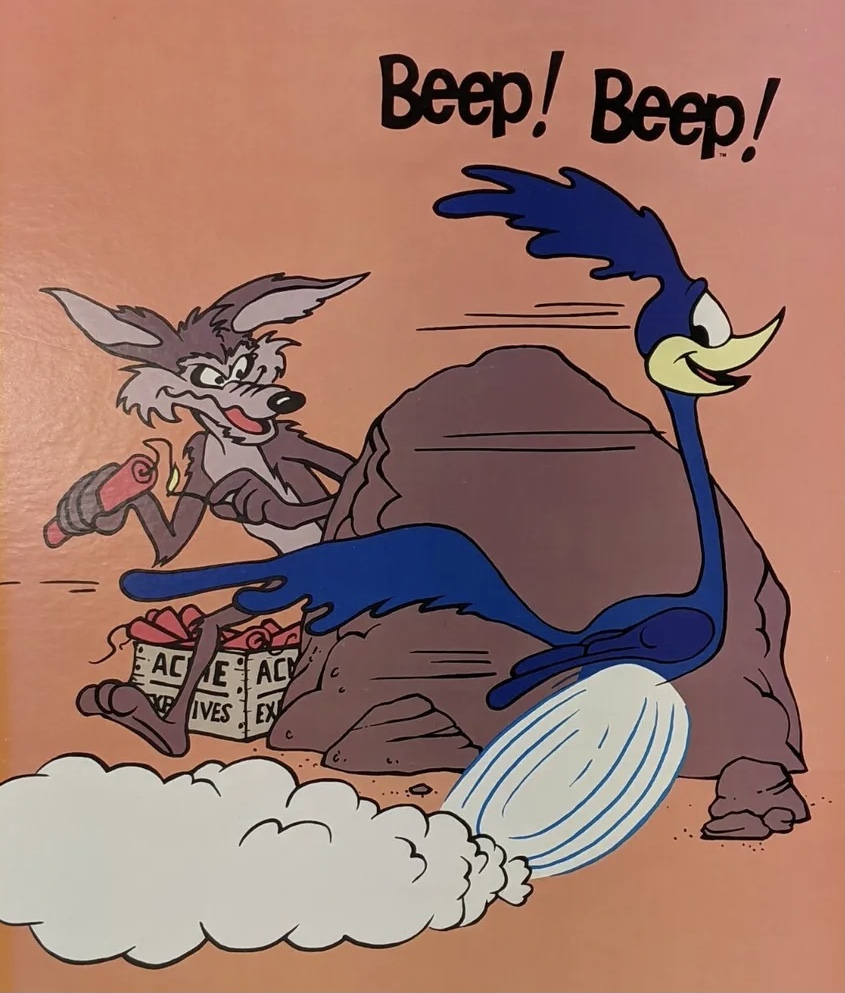 The roadrunner is the state bird of New Mexico. The roadrunner was made popular by the Warner Bros. cartoon characters Wile E. Coyote and the Road Runner, created in 1949, and the subject of a long-running series of theatrical cartoon shorts. In each episode, the cunning, insidious, and constantly hungry Wile E. Coyote repeatedly attempts to catch and subsequently eat the Road Runner, but is never successful. The cartoons led to a misconception that roadrunners say "Beep, Beep" because the roadrunner in this cartoon series made that sound instead of the aforementioned sound of a real roadrunner. In some shorts, the Road Runner makes a noise while sticking his tongue out at Wile E. Coyote, which resembles its actual call. The cartoons rely on a misconception that a roadrunner is much faster than a coyote. In fact, a coyote's fastest sprinting speed is 40 mph, which is greater than a roadrunner at 25 mph.
The roadrunner is the state bird of New Mexico. The roadrunner was made popular by the Warner Bros. cartoon characters Wile E. Coyote and the Road Runner, created in 1949, and the subject of a long-running series of theatrical cartoon shorts. In each episode, the cunning, insidious, and constantly hungry Wile E. Coyote repeatedly attempts to catch and subsequently eat the Road Runner, but is never successful. The cartoons led to a misconception that roadrunners say "Beep, Beep" because the roadrunner in this cartoon series made that sound instead of the aforementioned sound of a real roadrunner. In some shorts, the Road Runner makes a noise while sticking his tongue out at Wile E. Coyote, which resembles its actual call. The cartoons rely on a misconception that a roadrunner is much faster than a coyote. In fact, a coyote's fastest sprinting speed is 40 mph, which is greater than a roadrunner at 25 mph.In the United States roadrunners aren't common. Most people see them by chance along the road, as they make a mad dash across the asphalt or hunt reptiles basking in the sun. They run in a horizontal position, with their tail held flat and their head and chest tilted forward and down, level with the ground. Roadrunners can't fly well for long distances, so they limit their flight to short glides or bursts when startled. What does it mean when a roadrunner visits you? A Roadrunner symbolizes magic and good luck. Just spotting a roadrunner is considered very good luck. Roadrunners are native birds in the USA and you may not legally possess, harass, etc. a roadrunner or its eggs. This is a federal law as these birds are protected under the MBTA of 1918. It is heavily enforced and is punishable by jail time and up to $10,000 in fines. Click for More information on Roadrunners 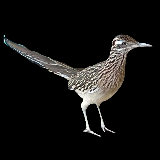
|
TAP ON THE VIDEOS FOR SOUND - Beep obeys my commands
THE DEATH OF THE RATTLESNAKE VIDEO - Tap the video for sound  |
Beau Productions Historical Websites

Copyright All Rights Reserved Beau Productions - 2001
Beep the Roadrunner counter
12-03-2023
